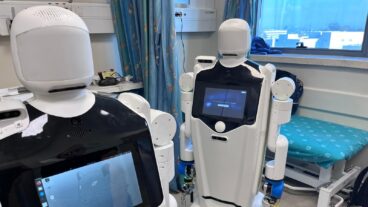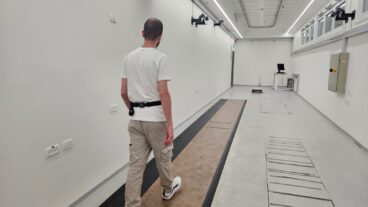An artist’s rendering of the distant solar system shows two newly discovered planets, resembling Jupiter and Saturn. Picture credit: Cheongho Han and colleagues at the Korea Astronomy and Space Science Institute.Astronomers from Tel Aviv University are part of an international team that has discovered a solar system nearly 5,000 light years away that is very much like our own.
The newly discovered solar system, which is unlike any of the other 10 solar systems found during the last decade, includes two planets that resemble the gaseous planets Jupiter and Saturn, and is similar to our own solar system in terms of planets, relative weights and distances between them.
Despite the similarities, the new solar system is smaller than our own. Its sun is only half the size of ours, issuing only five percent as much light, while the Jupiter and Saturn-like planets are about 80 percent as big as our own Jupiter and Saturn planets. The planets’ distance from their sun is half the distance of ours from the sun.
The report on the new findings was published in the February 15 edition of the journal Science.
The two planets were discovered when the star they orbit crossed in front of a more distant star seen from earth. The event was first detected by the Optical Gravitational Lensing Experiment (OGLE), which took place in March 2006. In the wake of this, Andrew Gould, a professor of astronomy at Ohio State, joined forces with OGLE and organized astronomers at 11 different locations worldwide, including Israel, New Zealand, Tasmania, Chile, the Canary Isles, and the US, to gather observations on the event.
For a two-week period in the spring of 2006, the astronomers watched as the nearer star magnified the light shining from the farther star in a phenomenon called gravitational microlensing, a technique first proposed in Albert Einstein’s General Theory of Relativity. In this case the phenomenon was particularly dramatic – the light from the more distant star was magnified 500 times.
The discovery of the double planet system was deemed a triumph for astronomers who use the gravitational microlensing method, which is of such high sensitivity that it can detect planets similar to those in our own solar system, with the exception of Mercury.
The Israeli data was provided by TAU’s Wise Observatory at Mitzpe Ramon. “Without our observations, which were carried out when it was daylight where the other observatories are located, it would have been impossible to conclude that the Saturn-like planet existed,” said Prof. Dan Maoz, a member of the Israeli team in an article in The Jerusalem Post.
“Only five planets have been discovered so far by the ‘lens’ technique,” he added. “What we have found hints to the existence of similar solar systems, and there may be some planets similar to Earth. If there are other Earths, they could be discovered soon.”
Scientists believe that the findings suggest that there could be large numbers of planetary systems like our own, a possibility that no doubt raises hopes among those who are convinced that extra-terrestrial life really does exist somewhere in the universe.![]()
Slashdot It!![]()












